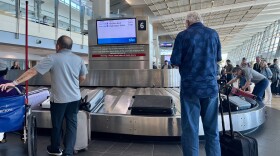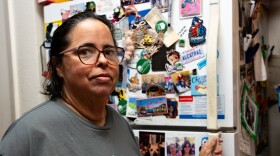Speaker 1: (00:00)
Ice surf hit the beaches last week, along with many local surfers, exposing some to potential raw sewage for years, surfers in the south bay have complained. They can smell it and taste it in the water. Now, a new study by the Scripps institution of oceanography at UC San Diego confirms it raising alarms about the, of the water along the border coastal region here to tell us more is KPPs investigative border reporter, Gustavo Gustavo. Welcome.
Speaker 2: (00:29)
Hello, thank you for having me.
Speaker 1: (00:31)
All right. So what does this study tell us?
Speaker 2: (00:34)
Well, the study focused on an area called Punta Bandera, uh, which is where sewage from a nearby treatment plant is dumped directly into the Pacific ocean, just six miles south of the border. And the study tells us that polluted water from Punta bads is pushed north to Imperial beach and Coronado during strong Southwell events. South swells are when the water's coming from the south, pushing everything north. And the interesting part of the study is that some of the bacteria that gets pushed up to Imperial beach is not detected in the county's water quality tests. So people can get sick from the water, even on sunny days when it hasn't rained and the county's tests show clean conditions.
Speaker 1: (01:17)
Hmm. So what has been the reaction of local surfers and other beach goers to the studies finding?
Speaker 2: (01:22)
Well, I think a lot of the surfers, uh, feel vindicated in a way, right? They they've been in the water for years and they've smelled, they've complained about smelling this like, uh, chemically, the Detert smell. Sometimes it just smells like feces even on, on days where it shouldn't right when it hasn't rained. And I think they all kind of know that this can happen, right? If you've ever been in the ocean and the current strong you go in at one point, and then the water pushes you north or south, depending on how far is traveling. So people kind of understand that the water works that way.
Speaker 1: (01:55)
Hmm. Do we have any idea of how many beach goers and surfers have gotten sick as a result of this sewage? There's
Speaker 2: (02:02)
No official count that I'm aware of in, in terms of how many people have, have gotten sick. I mean, anecdotally, most surfers who surf there regularly over the years have gotten sick. I mean, the mayor of Imperial beach search ed has said, he's gotten two sinus surgeries, two ear surgeries because of pollution throughout his life. He's been so surfing there since the seventies and the study does say that that their models show about just under 5% of people who are swimming in Imperial beach in the summer could get sick during Southwell right. It's important to remember this happens only when the water is floating north, if the water is going south and the, obviously the, a pollution is pulled south and this type of pollution, isn't really a, a factor.
Speaker 1: (02:48)
So what types of illnesses have surfers been reporting?
Speaker 2: (02:51)
Well, the main one is, is a neurovirus, which, which, which is in the water. Uh, it is not fun to have. I mean, it causes diarrhea, vomiting, nausea, stomach pain could also give you a fever. I've also spoken to surfers, uh, previous stories surfing further south by the Tijuana slew, uh, that have gotten hepatitis a from, from being in the water.
Speaker 1: (03:13)
And can you talk about the topography? I mean, and remind us why cross border water contaminate is such an issue in that area.
Speaker 2: (03:21)
The south part of San Diego county is, is pretty flat, but when you cross the border and go into Tijuana, it's full of canyons, those canyons, whenever it rains all the, the pollution from, from those houses and in those factories. And Maquis, it gets flushed down the canyons to the Tigua river. And that causes a lot of pollution. So like that's the main source in the winter time when it rains like this last December, we had record grains. Um, the other one is just the ocean, right? The water is dumped into the ocean. And when, when the current pushes it in our direction, there's really no voiding. It, some of that gets diluted naturally with the rip currents and, and just water flows in the ocean. But the research shows that some of it makes it and, and not just to Imperial beach, right. In particularly strong Southwell events, it makes it to Coronado as well.
Speaker 1: (04:11)
You know, this issue is nothing new to the coastal border region. I mean, what needs to happen to address these problems?
Speaker 2: (04:17)
Yeah. Well, multiple things need to happen on all fronts, right? Imperial beach is the victim of, of geography really, right. There's multiple sources of pollution, right? One is the Tijuana river, which carries polluted water from Tijuana north of the border. And E emptys out just north of, of, uh, friendship park in the border by the Tijuana SL. So that's one source and that's particular bad during rain events. So rain from the canyons of Tijuana will push it down into the river and all that stuff will go, uh, flush out naturally into the, the ocean by the river. The other one is obviously Punta Banderas, which is this, uh, uh, where water from this treatment plant is just dumped into the ocean. So you, you have to draw, I said, from multiple angles, but at the end of the day, it's an issue of infrastructure. And, and to be Frank at Tijuana and, and Baca, California, and the federal government of Mexico have just done a real poor job of, of investing in infrastructure and keeping up with growth, right? Tijuana almost has 2 million people living in there now, but their infrastructure is crumbling as a result of that, that pressure.
Speaker 1: (05:22)
And it seems like no one wants to take responsibility. So how would you classify cross-border cooperation on this issue today? Uh, is it working as well as it needs to,
Speaker 2: (05:31)
I would say, um, that it's working better than it has before. Um, although the bar has kind of been low, right. For a long time, Imperial beach would complain that that Mexican and officials would not even acknowledge that there were problems because doing so would, would kind of mean somebody was at fault, right? So they would just kind of do like a outta sight outta mind type of thing. But there have been more collaboration now recently in the last couple of years, particularly with binational organizations like the I BWC, which is the international boundary and water commission, and even the north American development bank, uh, which funds projects, development projects on both sides of the border. There has been more coordination through those venues. So
Speaker 1: (06:13)
Will this study have an impact on beach closures in and around Imperial beach? I mean, can we expect more closures after this report?
Speaker 2: (06:22)
That that's a little hard to say the county has been briefed on, on the report's findings and to be clear, no one is criticizing the county for how they do testing or not doing enough testing. The problem is that they'd have to change the way they do testing, right? It's relatively easy to test for what they're testing now, which are like the fecal indicators like E coli. But the, the issue with them is that those particles die pretty quickly when they're exposed to the sun. So if, if they're drifting up along the coast for, for 10 miles, they're gonna die before they get to Imperial beach. But the other particles that cause the viruses they'll survive, the, and those don't show up on the county's test. The issue is that testing for those particles that do survive require special equipment. And it, it is a lot more expensive. It's also important to mention that EPA scientist worked on this report and this research. So, so they're aware of the findings and the hope is that this report guides of the long term solutions that, uh, will determine how the EPA spends the hundreds of millions of dollars that have been allocated to fix this issue.
Speaker 1: (07:27)
I have been speaking with KPBS, investigative border reporter, Gustavo Salli Gustavo. Thank you very much.
Speaker 2: (07:33)
Right. Thanks for having me.






